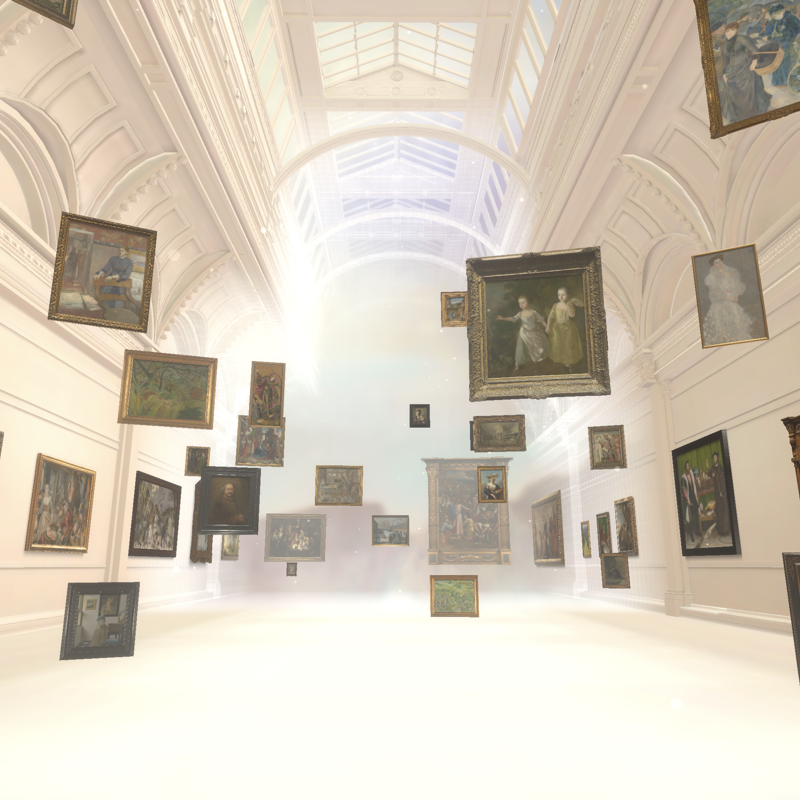Jacopo Tintoretto, 'Saint George and the Dragon', about 1555
About the work
Overview
Saint George plunges his lance into the jaws of the dragon which, according to legend, inhabited the lake outside the city of Lydda in the Holy Land. He has arrived just in time to save the princess, who had been presented as a sacrifice to the creature. The dead body of one of the dragon’s earlier victims lies on the ground. God the Father appears in the heavens in answer to George’s prayers and intervenes to help him defeat the dragon.
Tintoretto has devised a daring, dramatically heaving composition, with the horizon set two thirds up the picture and the figures positioned above one another receding obliquely into the distance. The headlong movement of the princess and Saint George is continued in the swirling draperies, rushing waters and thunderous clouds pierced by blinding beams of light in the heavens.
Although the painting was intended as an altarpiece it may always have been kept in a private domestic setting, probably a private chapel.
Key facts
Details
- Full title
- Saint George and the Dragon
- Artist
- Jacopo Tintoretto
- Artist dates
- about 1518 - 1594
- Date made
- about 1555
- Medium and support
- oil on canvas
- Dimensions
- 158.3 × 100.5 cm
- Acquisition credit
- Holwell Carr Bequest, 1831
- Inventory number
- NG16
- Location
- Room 9
- Collection
- Main Collection
- Previous owners
- Frame
- 16th-century Spanish or Italian Frame
Provenance
Additional information
Text extracted from the ‘Provenance’ section of the catalogue entry in Nicholas Penny, ‘National Gallery Catalogues: The Sixteenth Century Italian Paintings’, vol. 2, ‘Venice 1540–1600’, London 2008; for further information, see the full catalogue entry.
Exhibition history
-
2012TintorettoScuderie del Quirinale25 February 2012 - 10 June 2012
-
2017Tintoretto - A Star was BornWallraf-Richartz-Museum & Fondation Corboud6 October 2017 - 28 January 2018
-
2018Tintoretto 1519-1594National Gallery of Art (Washington DC)10 March 2019 - 7 July 2019
Bibliography
-
1924W.G. Constable, 'The Foundation of the National Gallery', The Burlington Magazine, XLIV/253, 1924, pp. 158-72
-
1934R.N.D. Wilson, The National and Tate Galleries, London 1934
-
1959Gould, Cecil, National Gallery Catalogues: The Sixteenth Century Venetian School, London 1959
-
1975C. Gould, Delaroche and Gautier: Gautier's Views on the 'Execution of Lady Jane Grey' and on other Compositions by Delaroche, London 1975
-
1979J. Plesters, 'Tintoretto's Paintings in the National Gallery: Part I', National Gallery Technical Bulletin, III, 1979, pp. 3-24
-
1980J. Plesters, 'Tintoretto's Paintings in the National Gallery: Part II', National Gallery Technical Bulletin, IV, 1980, pp. 32-47
-
1981J. Visscher, 'De verborgen handgreep: Jean-Paul Sartre en het schilderij "Sint-Joris en de draak" van Tintoretto', Gentsche Bijdragen tot de Kunstgeschchiedenis, XXVI, 1981, pp. 194-205
-
1982R. Pallucchini and P. Rossi (eds), Jacopo Tintoretto. L'opera completa, Venice 1982
-
1985F. Valcanover and T. Pignatti, Tintoretto, New York 1985
-
1987Gould, Cecil, National Gallery Catalogues: The Sixteenth Century Italian Schools, London 1987
-
1988J. Stumpel, 'On Grounds and Backgrounds: Some Remarks about Composition in Renaissance Painting', Simiolus, XVIII/4, 1988, pp. 219-43
-
1994G. Didi-Huberman, Saint Georges et le dragon: Versions d'une légende, eds R. Garbetta and M. Morgaine, Paris 1994
-
1996C. Bédard, 'Saint Georges à l'épreuve de Persée: Affrontements et démembrements', in F. Siguret and A. Laframboise (eds), Andromède ou le héros à l'épreuve de la beauté.: Actes du colloque international au musée du Louvre, 3-4 février 1995, Paris 1996, pp. 281-315
-
2001
C. Baker and T. Henry, The National Gallery: Complete Illustrated Catalogue, London 2001
-
2001Haks and M.C. Sman (eds), Dutch Society in the Age of Vermeer (exh. cat. Diözesanmuseum Freising, 20 May - 21 October 2001), Lindenberg i. Allgäu 2001
-
2007J. Dunkerton, 'Tintoretto's Underdrawing for "Saint George and the Dragon"', National Gallery Technical Bulletin, XXVIII, 2007, pp. 26-35
-
2007M. Falomir Faus (ed.), Tintoretto (exh. cat. Museo Nacional del Prado, 30 January - 13 May 2007), Madrid 2007
-
2008Penny, Nicholas, National Gallery Catalogues: The Sixteenth Century Italian Paintings, 2, Venice, 1540-1600, London 2008
Frame
This is a sixteenth-century Spanish or Italian tabernacle frame, based upon classical architecture. The carved and water-gilt frame features areas of polychrome and sgraffito. In the frieze of the predella tendrils with buds, cornucopias and scrolls flow from the eye sockets of a mask. Tapered fluted columns with Corinthian capitals are backed by carved leaves. On the entablature, carved figures – holding tridents and oars – face towards a central shield supported by putti. Six busts, intricately carved, painted and gilt, against a sgraffito background, look out from the projections of the entablature.
The frame was extended in 1962. New upper scroll brackets were inserted above the capitals and below the entablature. Ornamental spandrels were added to form the arch of the frame. The base and outer mouldings are also new additions.
Before its modifications, this frame was paired with Titian’s Portrait of a Lady (‘La Schiavona’).
About this record
If you know more about this painting or have spotted an error, please contact us. Please note that exhibition histories are listed from 2009 onwards. Bibliographies may not be complete; more comprehensive information is available in the National Gallery Library.








